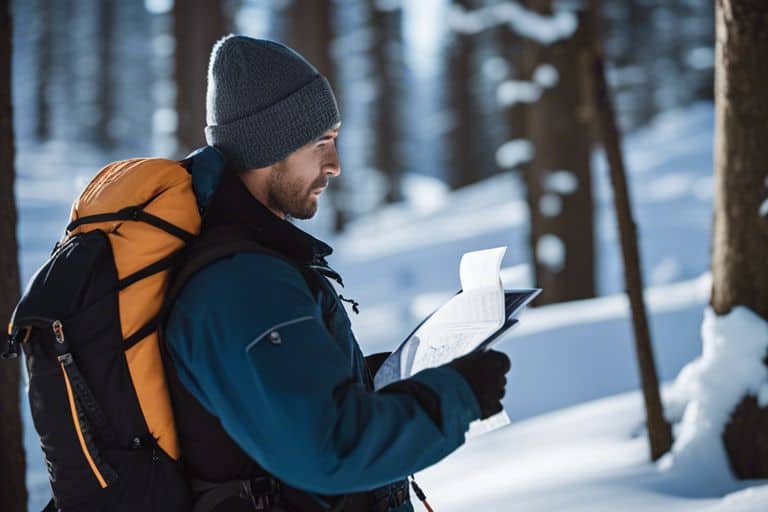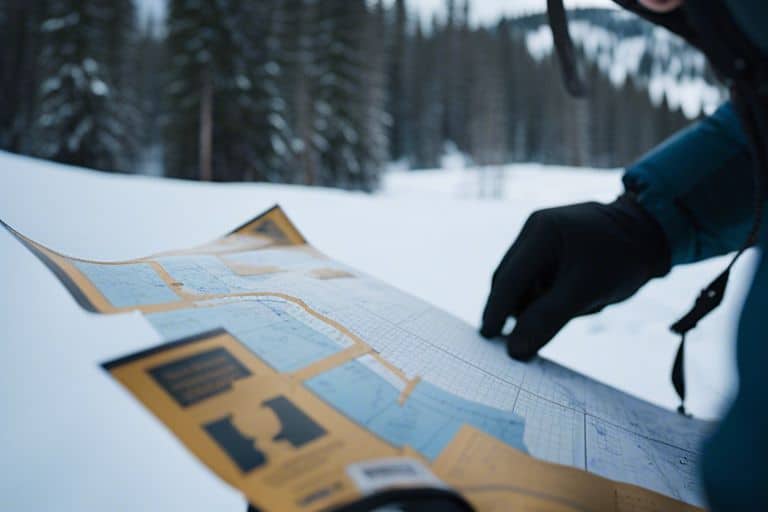When embarking on a winter hiking or trekking adventure, it is crucial that you are well-informed about the trail conditions. You should be aware of the potential hazards and challenges that await you. Evaluating winter trail conditions is vital to ensuring your safety and enjoyment during your outdoor activities.
The key factors to consider when evaluating winter trail conditions include the terrain and elevation of the trail, the weather forecast, the presence of ice and snow on the trail, and any recent avalanche activity in the area. You should also take into account the amount of daylight available, potential hazards such as falling branches or trees, and the access to emergency services. By carefully assessing these factors, you can make informed decisions about whether to proceed with your winter outdoor adventure or postpone it for safer conditions.
Key Takeaways:
- Weather Conditions: Weather plays a crucial role in determining trail conditions. Factors such as recent snowfall, temperature, and wind can significantly impact the safety and usability of winter trails.
- Terrain: The type of terrain and elevation of a trail can greatly affect its condition in winter. Steep inclines, rocky areas, and dense forests may pose additional challenges for hikers and outdoor enthusiasts.
- Trail Maintenance: Regular maintenance and grooming of winter trails are essential for ensuring safe and accessible conditions. Look for trails that are regularly cleared of snow, marked for visibility, and maintained for safety.
- Safety Precautions: It’s important to consider safety precautions when evaluating winter trail conditions. This includes carrying necessary gear such as traction devices, first aid kits, and communication devices, as well as informing others of your planned route and estimated return time.
- Local Knowledge: Seeking local knowledge and information from park rangers, outdoor organizations, or experienced hikers can provide valuable insights into the current conditions of winter trails. Don’t hesitate to ask for advice and guidance before venturing out.

Key Factors in Evaluating Winter Trails
Any time you are evaluating winter trails, there are several key factors that you need to take into consideration. These factors can help you determine the trail conditions and whether it is safe to venture out. Here are some important factors to keep in mind:
- Snow Depth: This is a crucial factor in determining the difficulty of a trail. Deep snow can make it more challenging to hike or ski, while shallow snow may not provide enough coverage for some activities.
- Surface Conditions: The type of snow and ice on the trail can greatly impact your experience. Hard-packed snow or ice can be slippery and difficult to navigate, while fresh powder can make for a more enjoyable outing.
- Temperature and Wind Chill: Cold temperatures and strong winds can make the trail conditions feel much harsher. It’s important to take these factors into account when planning your outing.
- Avalanche Risk: In areas with steep terrain, avalanche risk is a significant concern. Assessing the risk of avalanches is crucial to your safety on the trail.
Knowing these key factors will help you make informed decisions about which winter trails are safe and suitable for your outdoor activities.
Weather and Climate Impact
Weather and climate play a significant role in determining the winter trail conditions. The type and amount of precipitation, temperature, and wind can greatly impact the trail surface and snow coverage. For example, heavy snowfall can create deep snowdrifts and cover obstacles on the trail, making it challenging to navigate. On the other hand, warmer temperatures can cause the snowpack to melt and refreeze, resulting in icy and slippery conditions.
Additionally, strong winds can cause wind slab avalanches and create hazardous conditions on the trail. It is important to check the weather forecast and climate patterns for the area you plan to visit to anticipate the potential impact on the winter trail conditions.
Equipment and Gear for Trail Assessment
The equipment and gear you use for assessing winter trail conditions are crucial for accurate evaluation. Not only does the right equipment ensure your safety, but it also allows you to gather the most precise data and make informed decisions about trail use.
Necessary Tools for Accurate Measurement
When evaluating winter trail conditions, having the right tools for accurate measurement is essential. One of the most important tools is a quality snow depth gauge, which allows you to measure the depth of snow on the trail accurately. Another crucial tool is a thermometer, which helps you monitor temperature changes that can affect the trail conditions. Additionally, a compass and map are essential for navigation, especially in areas where trails may not be well-marked. These tools, when used in combination, provide you with the necessary data to assess trail conditions accurately.
Innovations in Winter Trail Equipment
Advancements in technology have brought about innovations in winter trail assessment equipment that have greatly improved the accuracy and efficiency of the process. One such innovation is the use of GPS devices, which allow you to track your location and map the trail conditions in real-time. Another innovation is the development of lightweight, durable equipment, such as snowshoes and trekking poles, designed to provide you with stability and traction in challenging winter conditions. These innovations have made it easier than ever to gather the data you need to make informed decisions about trail conditions.
Trail Use and Maintenance
Your winter trail experience can be greatly affected by the way the trail is used and maintained. It’s important to consider how recreational activities on the trail can impact its condition, as well as the strategies for maintaining winter trails in optimal condition.
Assessing the Effect of Recreational Activities
When evaluating winter trail conditions, it’s crucial to assess the effect of recreational activities such as hiking, snowshoeing, and skiing. These activities can compact the snow, leading to icy and uneven surfaces. Additionally, heavy foot traffic can create deep ruts, making the trail challenging to navigate. It’s important to consider the type and frequency of recreational activities on the trail to accurately gauge its conditions.
Maintenance Strategies for Winter Trails
Proper maintenance is essential for ensuring winter trails remain safe and accessible. Regular grooming, including snow packing and leveling, is essential for creating a smooth and even surface. Trail markers and signage should be maintained and updated to ensure clarity of direction and safety for users. Furthermore, proactive measures such as removing fallen trees and clearing snow drifts can significantly improve trail conditions. Regular inspection and maintenance efforts are crucial for preserving the integrity of winter trails.
Safety and Risk Management
Despite the picturesque and serene winter landscapes, it is essential to always be mindful of safety when hitting the trails during the winter season. Winter trail conditions can pose significant risks, and it is vital to be well-prepared and aware of potential hazards to minimize the inherent dangers.
Identifying Hazardous Sections
When evaluating winter trail conditions, it is crucial to identify hazardous sections that could pose risks to your safety. These may include steep and icy terrain, deep snow, avalanche-prone areas, and areas with hidden obstacles such as fallen trees or rocks. Pay close attention to areas with potential for snow drifts and unstable snowpack, as well as sections where the trail may be obscured by heavy snowfall. It is important to assess these hazards and make a conscious decision about whether you can safely navigate these sections.
Implementing Safety Measures and Protocols
Once you have identified hazardous sections, it is essential to implement safety measures and protocols to mitigate the associated risks. This may involve using appropriate gear such as crampons or snowshoes for traction, carrying an avalanche beacon and probe, and making sure you are equipped with essential survival gear. Additionally, you should consider implementing safety protocols such as traveling in groups, informing someone of your itinerary, and regularly checking in to provide updates on your whereabouts. Your safety should always be a top priority when venturing out into winter trail conditions.
Techniques for Trail Conditioning and Preparation
After evaluating the winter trail conditions, it’s important to prepare and condition the trail for safe and enjoyable use. Below are some key techniques for trail conditioning and preparation that will help ensure a positive experience for trail users.
Improving Trail Durability and Stability
One of the most important factors in trail conditioning is improving trail durability and stability. You can achieve this by addressing erosion, water drainage, and natural obstacles. By maintaining proper drainage systems, you can prevent erosion and create a more stable trail surface. Additionally, addressing natural obstacles such as fallen trees and large rocks will enhance trail durability and safety. By ensuring the trail is sturdy and stable, you can reduce the risk of accidents and provide a more enjoyable experience for everyone.
Training and Techniques for Trail Grooming
When it comes to trail grooming, proper training and techniques are essential for achieving the best results. Proper grooming techniques can help create a smooth and even trail surface, reducing the risk of injuries and accidents. Training and experience in trail grooming are crucial for understanding how to use grooming equipment effectively and safely. By implementing the right techniques, you can create a well-groomed trail that is both safe and enjoyable for users. It’s important to invest in ongoing training and education to ensure that you are equipped with the necessary skills to groom winter trails effectively.
Environmental and Ecological Considerations
Now, let’s delve into the environmental and ecological factors that play a crucial role in evaluating winter trail conditions. It’s important to understand the impact of these factors on the trail and how your use of it affects the surrounding environment.
The Role of Flora and Fauna in Trail Conditions
When assessing winter trail conditions, it’s essential to consider the role of flora and fauna in the ecosystem. The presence of plant life and wildlife can impact trail conditions in various ways. For example, heavy foot traffic on trails during winter can disrupt the natural habitats of wildlife, causing them stress and potentially endangering their survival. Additionally, trampling on vegetation can lead to soil erosion and other forms of environmental degradation, affecting the overall health of the trail ecosystem.
Balancing Trail Use with Conservation
Another important consideration is finding a balance between trail use and conservation efforts. While enjoying winter trails, it’s crucial to minimize your impact on the environment. By following designated paths and respecting wildlife habitats, you can help preserve the natural beauty of the area. It’s important to remember that your actions have a direct impact on the ecosystem, and by being mindful of your impact, you can contribute to the conservation of the trail and its surrounding environment.
In order to find important winter trail information, you can check out Important Winter Trail Information provided by qualified sources for crucial knowledge about winter trails.
Conclusion
Presently, you should have a thorough understanding of the key factors to evaluate winter trail conditions. By considering the weather, snowpack, and terrain, you can make informed decisions about whether it is safe to venture out on a winter trail. Remember to always stay updated with weather forecasts and avalanche bulletins to ensure you are aware of any potential dangers. It’s crucial to prioritize your safety and the safety of others when enjoying the winter outdoors.
Additionally, always be prepared with the appropriate gear, such as avalanche safety equipment and sturdy footwear, to handle the conditions you may encounter on the trail. By keeping these factors in mind and staying informed, you can ensure a safe and enjoyable winter trail experience. Happy trails!
FAQ
Q: What factors should I consider when evaluating winter trail conditions?
A: When evaluating winter trail conditions, it is important to consider factors such as the amount of snow and ice on the trail, the presence of obstacles such as fallen trees or branches, the steepness and elevation of the trail, and the temperature and weather conditions. Additionally, it is important to take into account any recent changes in weather or trail maintenance that could impact trail conditions.
Q: Why is it important to evaluate winter trail conditions before heading out for a hike or outdoor activity?
A: Evaluating winter trail conditions is critical for ensuring the safety of hikers and outdoor enthusiasts. By carefully assessing factors such as snow and ice levels, obstacles, and weather conditions, individuals can make more informed decisions about whether it is safe to venture out onto a trail. This can help prevent accidents, injuries, and getting lost in the wilderness.
Q: How can I assess winter trail conditions before setting out on a hike or outdoor adventure?
A: There are several ways to assess winter trail conditions before heading out. These include checking weather forecasts and trail reports, contacting local park or trail authorities for updates, and using online resources and social media groups to gather information from fellow hikers and outdoor enthusiasts. It is also helpful to have the appropriate gear, such as traction devices for icy trails and extra layers of clothing, to prepare for varying trail conditions.



0 Comments